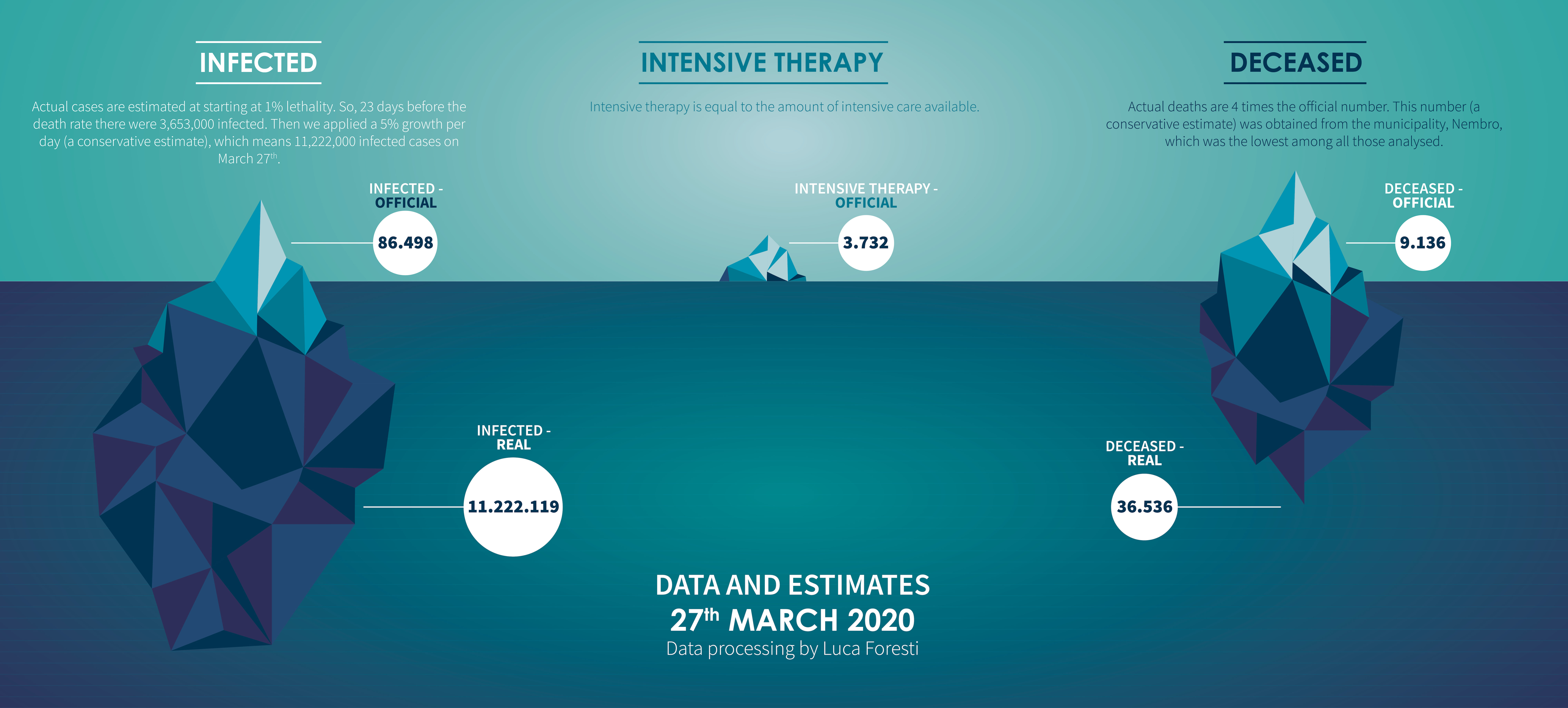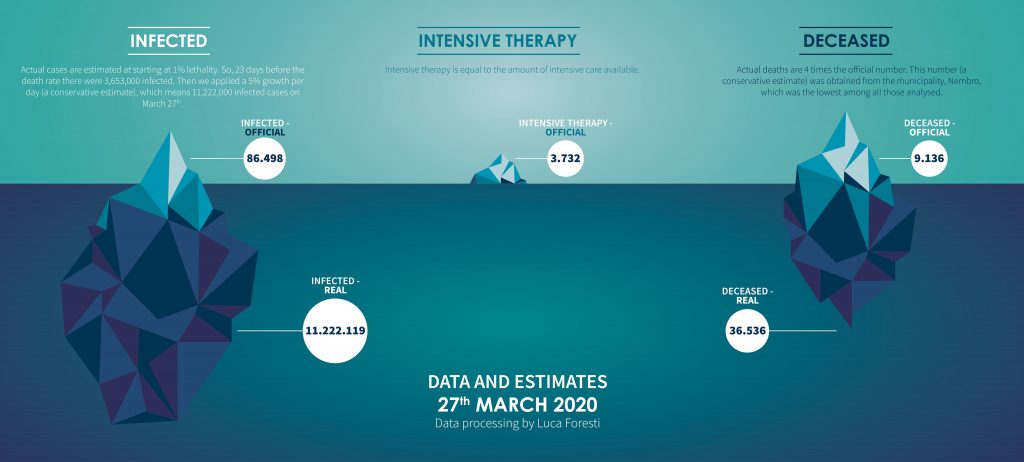Article originally published on Corriere della Sera, translated by Vito Maraula
How many people are actually infected by Sars-CoV-2 in Italy? This is the crucial question for those involved in developing the strategy for containing the epidemic. Today we know that the official numbers have been underestimated, especially in Lombardy, because the number depends on the number of swabs that were made. But we don’t know for how long this has been going on. In recent days Luca Foresti, managing director of the Santagostino Medical Centre, physicist and mathematician, has shown, together with the mayor of Nembro Claudio Cancelli, that the deaths caused by the coronavirus are at least 4 times the official ones (a phenomenon later found also in Spain). Now he has come up with an estimate of infected cases far above the official figures: “According to my calculations, there are at least 11,200,000 Italian people who contracted the virus as of March 27th. As cases ascertained by swab testing corresponded to 86,498, this means that we are seeing 0.7% of actual infections. And this has happened because today, especially in Lombardy, we make swab tests only for sufficiently severe symptoms. While we don’t do these tests for those with symptoms at home, to the less-symptomatic doctors who continue to work, and to asymptomatics.”
It is a huge number. What brought you to this conclusion?
“In an indirect way: starting from the lethality of the virus. We know that this number is around 1% (as confirmed by the analysis of the ISPI researcher Matteo Villa in Corriere), even though in Italy it seems higher. There are two ‘gold standards’ that show this: the case of the Diamond Princess cruise ship, where it was possible to test the whole ‘population’, and that of South Korea, which has done a huge number of tests. In Korea, lethality was lower than on the ship because Koreans are young and this virus is dangerous, for the most part, for elderly people: if we apply it to Italy, considering the age groups of its inhabitants, there is a slightly higher lethality rate high, around 1.2%.”
How did you arrive at the number of infected?
“Take Nembro, one of the towns most affected by the epidemic. We know, also demontrated by the mayor Cancelli, that there have been 120 real deaths for Covid-19, that is, four times the official deaths (because people who die at home or in residences for the elderly are almost never tested and therefore do not appear in the official statistics). If these correspond to 1.1% of those infected, it means that about 11,000 people have contracted the virus, many without realising it because they are asymptomatic. Which is exactly the number of inhabitants of Nembro. We have applied the same reasoning to Italy.”
And what did you discover?
“As of March 27th, there were 9,134 official deaths for Covid-19. For getting the actual number, we multiplied it by 4: there have been 36,536 deaths. If only 1% of the infected die, it means that the number of deaths corresponds to 3,653,600 positive people.”
But you are talking about over 11 million infected.
“Yes, because we know that the average time that passes between when a person is infected and when they die is 23 days. In the meantime, however, infections continue to spread. So 3,653,600 is the number of infected people 23 days earlier. Estimating an average increase in infections of 5% per day would reach 11,222,119.”
Where does that 5% come from?
“This is also a very conservative estimate: we know that the official deaths in the last few days have grown by about 10% per day, which means that 23 days earlier the infections also increased by 10% per day. We halved the rate to take into account the effects of the containment measures. The result however is a very high number of infected people. We could confirm this directly by testing the population or representative samples of the population with serological testing, which would tell us who has been infected with the virus, even if there are asymptomatic cases (as suggested also by former Istat presidents, Giorgio Alleva and Alberto Zuliani, ed. ), but the calculation is solid. The numbers of deaths and positives that we officially see are only the tip of the iceberg compared to the actual ones.”
What consequence does this have in practice?
“By understanding the actual size of the problem it would allow us to act sensibly. At this point there are two things that should be done: one is to test the population extensively, find all the positives and isolate them, and at the same time identify those who are now immune because they have already been infected, even if they do not know it. The other is to work on easing the population through risk bands, keeping over 65s and frail people in their homes, and starting to ease the lockdown for those people that are immune, or for whom the virus is less dangerous.”
If these numbers are well founded, it means that many people have had the virus without realising it. How is it possible that it is so dangerous then?
“The root of the problem with this virus is right here. Sars was more lethal and less viral and therefore allowed for an easier identification process of who was sick, and then isolate them. The same thing happened with the Asian woman who arrived in Italy in the 1960s: those who were infected immediately found themselves with a fever at 40 degrees, so they stayed at home and did not spread the epidemic. Covid-19 is not very lethal for a part of the population who often carry it around without knowing it. But it is too lethal for another part of the population and therefore causes a high number of deaths and a huge health problem.”

